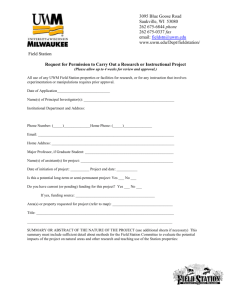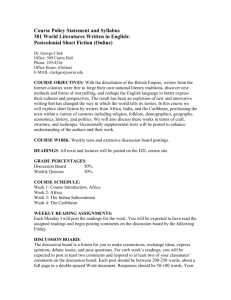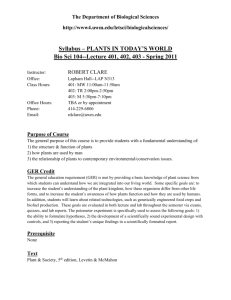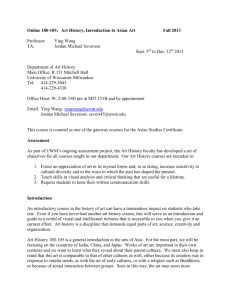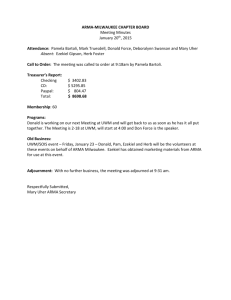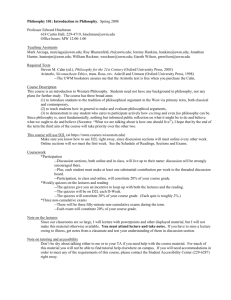Legal Issues in Records Management
advertisement
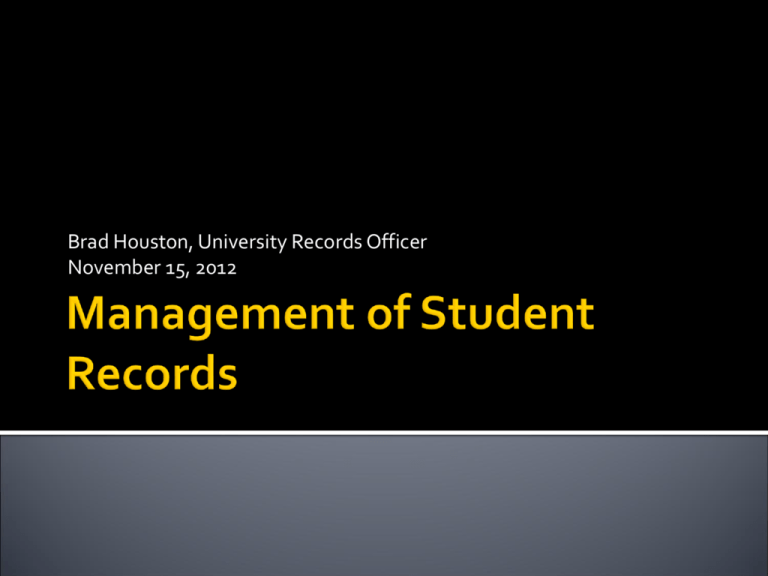
Brad Houston, University Records Officer November 15, 2012 Created whenever you interact with students Gradebooks Student Coursework Email Correspondence Retained for grade appeals, audits Privacy laws and concerns: dictates disclosure Introduce participants to relevant policies and schedules for student records Discuss retention and privacy requirements under Family Education Rights and Privacy Act (FERPA) Focus on electronic records and requirements for storing and producing digital files PAWS D2L Procedures, retention, best practices Recorded information, in any format, that allows an office to conduct business Value determined by content Four types of record value: Administrative Legal Fiscal Historical Personal materials Working notes and drafts Once a draft is shared with colleagues, it becomes a “record” Envelopes and routing slips Duplicate copies Includes vast majority of “cc” email Any Record created in the course of dealing with students or their information Vital ▪ Transcripts, accounts, enrollment lists Administrative ▪ Transcripts, Add/Drop forms, etc. Academic ▪ Grades, Coursework, Exams, etc. Advising ▪ Case files, disciplinary files, email or written correspondence Essential records covering student’s entire career Most of these records either permanent, or very long-term temporary Key example: Student Transcripts, 75-year retention Student Accreditation records? Copies are NOT essential and may usually be destroyed when no longer needed Records created for day-to-day administrative tracking of students School/Department offices most likely to have these records Generally high administrative value, little to n0 long-term value Credit/no-credit approvals: 1 year after submitted Add/Drop Records: 1 year after submitted Entrance exams/placement tests: 5 years for enrolled students, 2 years for non-enrolled Audit authorizations: 1 year after submitted Records created over course of academic course Usually held by individual instructors Very high administrative value; almost no long-term value Academic and Grade Appeals! UWM Select Policies S-28 and S-29 Students have up to one year to appeal grades Records kept through ALL levels of appeals Academic Records must show: No error made in grade calculation Grade conforms to announced grading policy Work done by students removing incomplete Consistent grade calculation for new incompletes Grade Books: 1 year after grades assigned Student Coursework: 1 year after grades assigned Usually final exams the only example of these materials that are retained Copies of papers, midterms, etc. fall under this Course Syllabi: 2 years after semester ends and transfer to archives Why? Proof of grading policy consistency Email correspondence with students IS a record (UWCOMM001) If you discuss grading policy/rationale with students, that correspondence CAN be used in appeal or litigation If in doubt, discuss grades only in person Records relating to student academic career, but not necessarily academic in nature Often copies of vital or administrative student records Usually held by department/office; may be held by Dean’s Office or Student Life Most inconsistently scheduled of the main categories Honors College Student Files: 5 years after creation Academic dishonesty records: 5 years after close of case (Dean of Students) CIE International Student Files: 2 years after closed See also UWSA General Schedule: http://www.wisconsin.edu/gc-off/records/schedules/GRS.Academic.Advising.pdf The brief version: 3 years for UG+Grad, 8 for certificates, 2 for prospective Determine any statutory requirements for retaining records Determine administrative/reference use beyond statutory requirements Contact UWM Records Management to create records schedule Usually about a 3 month lag between submission and approval by state Public Records Board Disclosure rules for Student Records Students have right to view educational records Educational records are only accessible to student Student may authorize disclosure Directory Information may be made available Exception: if a student has opted-out Certain other exceptions exist All records pertaining to students maintained at UWM Presumption of confidentiality Major exceptions: Instructor personal/sole possession notes Employment Records Campus Security Records Alumni records Defined as information publicly available: Name, Address, Contact Info Year in school, major, enrollment status Participation in activities Degrees, graduation date, awards received Students may choose to opt out of directory information release Contact Enrollment Services Campus Directory? Individual Students UWM Employees with “Genuine Educational Interest” Exempted classes Financial Aid Providers Other educational institutions (for transfers, etc.) Specifically exempted officials (FERPA Manual) Accrediting groups/student study groups Students must provide WRITTEN consent (with signature), including: Specification of records to be released Identify to whom records may be released Indication of purpose of release Provide requested records within 45 days No consent needed if records are subpoenaed or requested via public records request But contact Records Custodian first to determine validity of subpoena Keep a log of all disclosures of FERPAprotected information Exceptions: access by student or student- permitted party, directory info disclosure Keep a log of notifications to students of disclosure Maintain letters of consent for AT LEAST six years after student graduates/leaves UWM Release FERPA-protected information to parents Exception: if student is under 18 Post test or course grades using social security numbers Provide records to UWM staff without “legitimate educational interest” Yes! But make sure first: You have the student’s permission You have redacted any identifying information from copies displayed or distributed Do not disclose student information if you have ANY doubt re: permissions Contact Legal Affairs for guidance Advise requestor to direct request to Public Records Custodian Current Legal Affairs stance: presume ALL student information is private Why? Directory Info “Opt Outs” Wisconsin Administrative Rule 12, D2L, PAWS Electronic documents are records too, and subject to public records request! Records in Content Management Systems (e.g. D2L or PAWS) may be used as evidence in grade appeals/grievances PAWS/D2L issue: what constitutes the “record” in these databases? D2L COURSE SITE D2L COURSE MATERIALS Components that remain the same across iterations of the course Non-student specific Built into the site structure Usually not used for documentation Components that change across iterations of the course Example: grade information Usually student-specific Content created for course Example: Discussion Forum Threads Main source of course documentation “Examinations, coursework, assignments, etc. as retained by academic departments to serve as source documents for submitted official grades.” Retention time: 6 months after grades submitted n.b. If D2L records are ONLY copy of grade records, save for 1 year after submission instead ▪ Export, export, export! Remember to go in and remove relevant documents/records once retention expires Course data that “hangs around” could be subject to discovery UW System has established annual cleanup cycle for all course sites Courses after certain retention period deleted yearly If you do want to save something, make local copies In general, records created through PAWS are responsibility of Enrollment Services Access to student records subject to same FERPA privacy/disclosure requirements If you submit grades through PAWS, retain your own copy for record-keeping purposes Puts forth criteria for maintaining electronic records Mandates design and use of information systems to support e-records Does NOT require departments to maintain records electronically DOES apply to records already being maintained electronically exclusively Electronic records must be: Accurate: reflects the original record Accessible: Record can be retrieved Authentic: can be substantiated as accurate Reliable: produces the original record every time Legible: letters and numbers are identifiable Readable: Groups of letters recognized as words All of these properties must be maintained throughout a record’s active life Online (within D2L or PAWS system) Convenient, but may involve access restrictions Off-line (Print out) Most reliable, but most unwieldy Near-line (PantherFile or Dept. LAN) Reliable, moderately accessible Don’ t rely on one hard drive for this “Cloud computing” lets you store and access records remotely Dropbox, Google Docs, etc. UWM does not have contracts with any of these services Security, Access not guaranteed Be aware of FERPA concerns Summary and resources Retain most student academic records for at minimum 1 year Retain administrative or advising student records according to schedules Do not disclose student records outside of specific exceptions Prepare to preserve or purge electronic records, as appropriate UWM FERPA Guide https://www4.uwm.edu/current_students/records_grades/ ferpa_facstaff.cfm UWM Select Policy 29: Grade Records and Retention http://www4.uwm.edu/secu/acad%2Badmin_policies/S29. htm UWSA General Records Schedule for Academic Records http://www.uwsa.edu/gc- off/records/schedules/studentrecsboilerplateUWROC.pdf UWM General Records Schedules http://www4.uwm.edu/libraries/arch/recordsmgt/ common.cfm Records Management Guidelines http://www4.uwm.edu/libraries/arch/recordsmgt/ guidelines.cfm D2L Cleanup Blog http://d2lcleanup.blogspot.com/ This presentation available online: http://www.uwm.edu/Libraries/arch/recordsmgt/legal.ppt Or, contact UWM Records Management: houstobn@uwm.edu (Brad Houston) 414-229-6979 http://www.records.uwm.edu

